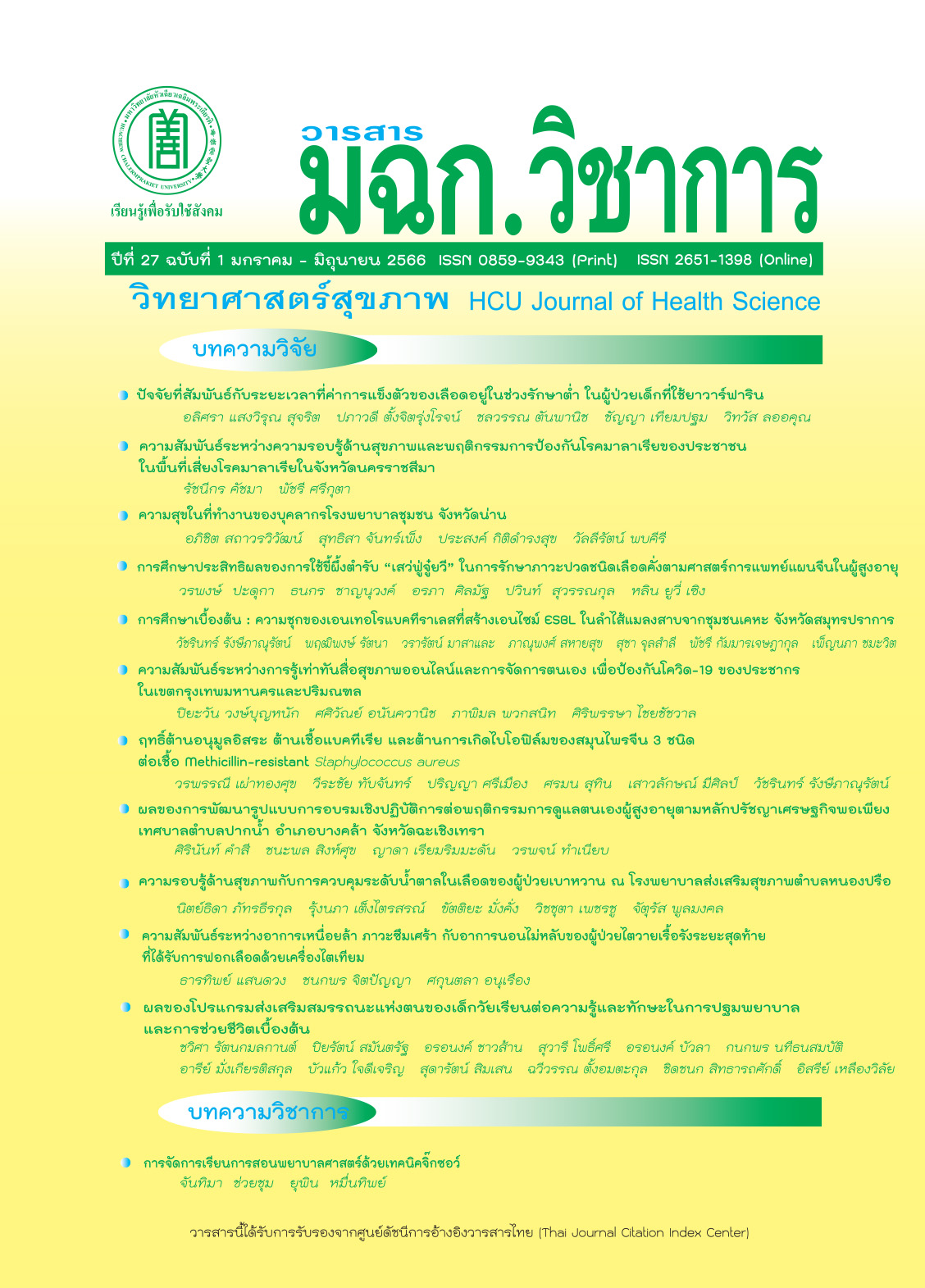Factors affecting effectiveness and safety of warfarin in pediatric patients
Keywords:
warfarin, pediatrics, %TTR, time in therapeutic rangeAbstract
The objective of this study was to examine factors affecting effectiveness and safety of warfarin in pediatric patients. This retrospective descriptive study was conducted at King Chulalongkorn Memorial Hospital. The clinical and medication-related data of patients aged 1-18 years, receiving warfarin between January 2015 and December 2020 were collected. Data were analyzed by descriptive statistics and multiple logistic regression. A total of 102 pediatric patients, the result showed that pediatric patients who did not have any surgery during warfarin treatment have by 9.67 times the odds of having the percentage of Time in Therapeutic Range (%TTR) more than 65, compared to patients that have surgery by adjusted with gender, age, weight, drug-drug interactions and non-compliance (adjusted OR 9.67, p=0.037). Moreover, TTR is lower than the therapeutic target (median: 38.3; IQR: 21.4, 67.4). However, this study found thromboembolism only 2 patients and only one patients of major bleeding. In conclusion, surgery during warfarin treatment in pediatric patients is important factor that affects the percentage of Time in Therapeutic Range that may affects to effectiveness and safety of pediatric patients using warfarin.
Downloads
References
Ansell J, Hirsh J, Hylek E, Jacobson A, Crowther M, Palareti G. Pharmacology and management of the vitamin K antagonists: American College of Chest Physicians Evidence-Based Clinical Practice Guidelines (8th Edition). Chest 2008;133(6 Sppl):160S-98S.
Johnson JA, Cavallari LH. Warfarin pharmacogenetics. Trends Cardiovasc Med 2015;25(1):33-41.
Jain S, Vaidyanathan B. Oral anticoagulants in pediatric cardiac practice: A systematic review of the literature. Ann Pediatr Cardiol 2010;3(1):31-4.
Ageno W, Gallus AS, Wittkowsky A, Crowther M, Hylek EM, Palareti G. Oral anticoagulant therapy: Antithrombotic Therapy and Prevention of Thrombosis, 9th ed: American College of Chest Physicians Evidence-Based Clinical Practice Guidelines. Chest 2012;141(2 Suppl):e445-e88S.
Male C, Monagle P, Albisetti M, Brandao LR, Young G. Direct oral anticoagulants: overcoming the challenges of managing venous thromboembolism in children. J Pediatr 2022;240:14-23.
Seltzer JH, Farrell A, Goldenberg N, Hornik C, Keene D, Krucoff MW, et al. Defining the path ahead for NOAC use in the pediatric population: A Cardiac Safety Research Consortium Think Tank. Am Heart J 2020;224:138-47.
Streif W, Andrew M, Marzinotto V, Massicotte P, Chan AK, Julian JA, et al. Analysis of warfarin therapy in pediatric patients: a prospective cohort study of 319 patients. Blood 1999;94(9):3007-14.
Santos BB, Heineck I, Negretto GW. Use of warfarin in pediatrics: clinical and pharmacological characteristics. Rev Paul Pediatr 2017;35(4):375-82.
Bonduel MM. Oral anticoagulation therapy in children. Thromb Res 2006;118(1):85-94.
Young G, Male C, van Ommen CH. Anticoagulation in children: making the most of little patients and little evidence. Blood Cells Mol Dis 2017;67:48-53.
Bauman ME, Hawkes M, Bruce A, Siddons S, Massicotte P. Immunizations in children requiring warfarin therapy. J Pediatr Hematol Oncol 2016;38(8):e329-e32.
Hawcutt DB, Ghani AA, Sutton L, Jorgensen A, Zhang E, Murray M, et al. Pharmacogenetics of warfarin in a paediatric population: time in therapeutic range, initial and stable dosing and adverse effects. Pharmacogenomics J 2014;14(6):542-8.
The Heart Association of Thailand under the Royal Patronage of H.M. the King. Warfarin guideline [Internet]. 2010 [cited 2022 Sep 9]. Available from: www.thaiheart.org/images/column 1292154183/warfarinGuideline(1).pdf
Warfarin [Internet]. In: Lexicomp@ Interactions Module. UpToDate, Inc. 2022 [cited 2022 Sep 10]. Available from: http://online.lexi.com/Ico/action/interact#
Schulman S, Kearon C, Subcommittee on Control of Anticoagulation of the S, Standardization Committee of the International Society on T, Haemostasis. Definition of major bleeding in clinical investigations of antihemostatic medicinal products in non-surgical patients. J Thromb Haemost 2005;3(4):692-4.
Hosmer DW, Lemeshow S, Sturdivant RX. Applied logistic regression. 3rd ed. Hoboken, New Jersey: John Wiley & Sons; 2013.
Al-Metwali BZ, Rivers P, Goodyer L, O'Hare L, Young S, Mulla H. Personalised warfarin dosing in children post-cardiac surgery. Pediatr Cardiol 2019;40(8):1735-44.
Labaf A, Sjalander A, Stagmo M, Svensson PJ. INR variability and outcomes in patients with mechanical heart valve prosthesis. Thromb Res 2015;136(6):1211-5.
Bonduel M, Sciuccati G, Hepner M, Torres AF, Pieroni G, Frontroth JP, et al. Acenocoumarol therapy in pediatric patients. J Thromb Haemost 2003;1(8):1740-3.
Lu H, Rosenbaum S. Developmental pharmacokinetics in pediatric populations. J Pediatr Pharmacol Ther 2014;19(4):262-76.
Tait RC, Ladusans EJ, El-Metaal M, Patel RG, Will AM. Oral anticoagulation in paediatric patients:dose requirements and complications. Arch Dis Child 1996;74(3):228-31.
Downloads
Published
How to Cite
Issue
Section
License
Copyright (c) 2023 HCU Journal

This work is licensed under a Creative Commons Attribution-NonCommercial-NoDerivatives 4.0 International License.
บทความที่ได้รับการตีพิมพ์เป็นลิขสิทธิ์ของวารสารวิทยาศาสตร์สุขภาพและสุขภาวะ
ข้อความที่ปรากฏในบทความแต่ละเรื่องในวารสารวิชาการเล่มนี้เป็นความคิดเห็นส่วนตัวของผู้เขียนแต่ละท่านไม่เกี่ยวข้องกับมหาวิทยาลัยหัวเฉียวเฉลิมพระเกียรติ และคณาจารย์ท่านอื่นๆในมหาวิทยาลัยฯ แต่อย่างใด ความรับผิดชอบองค์ประกอบทั้งหมดของบทความแต่ละเรื่องเป็นของผู้เขียนแต่ละท่าน หากมีความผิดพลาดใดๆ ผู้เขียนแต่ละท่านจะรับผิดชอบบทความของตนเองแต่ผู้เดียว




